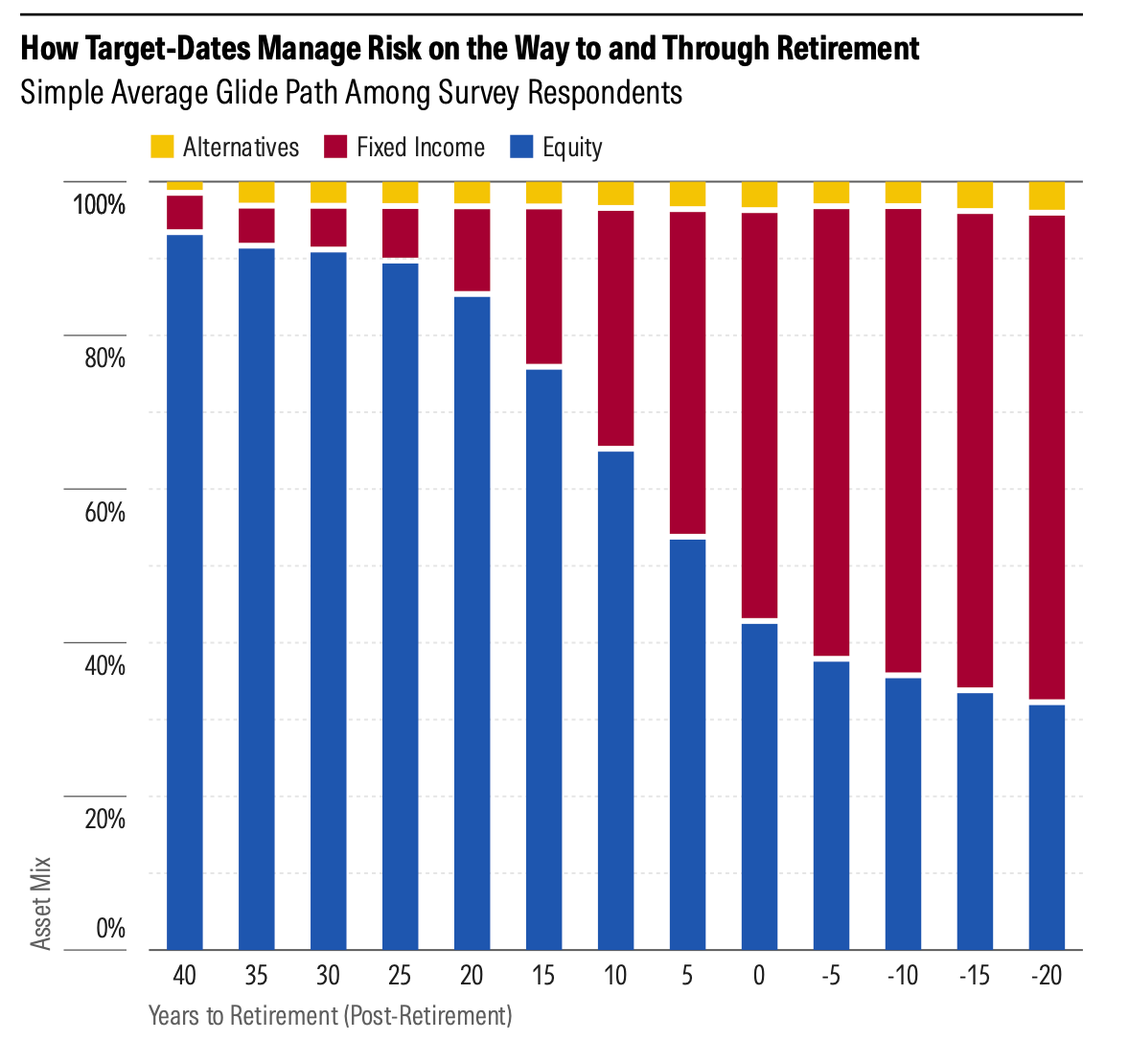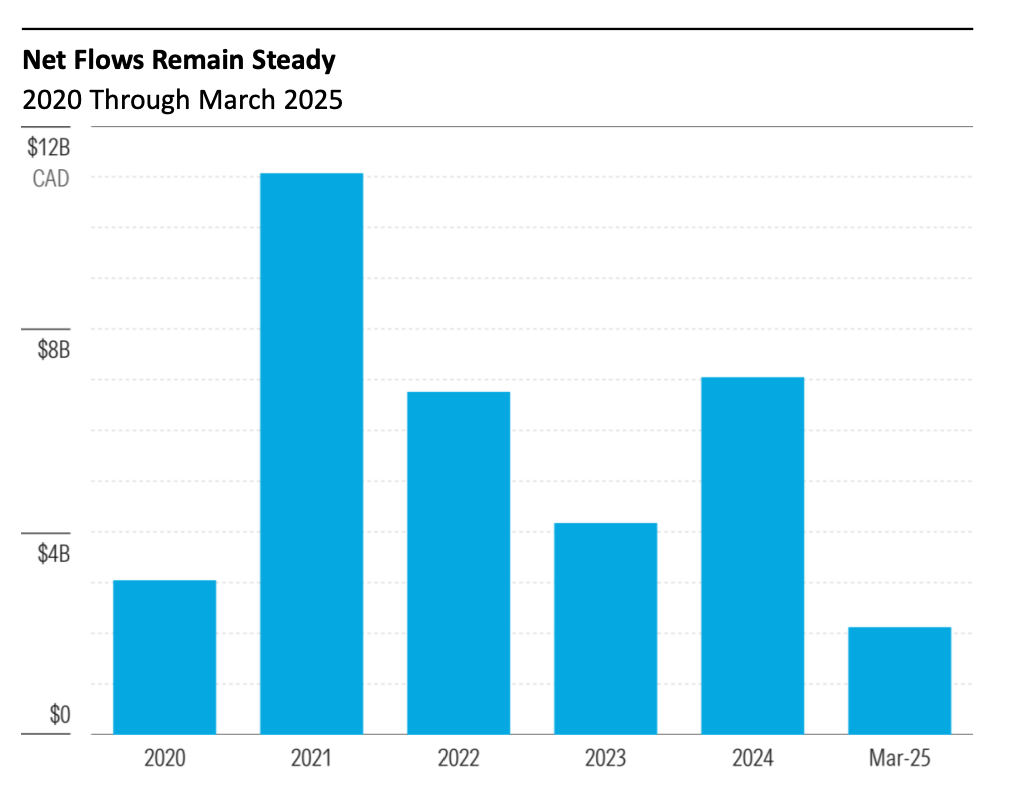6 min read
Canadian Target-Date Strategies: A Guide to Retirement Investing

On this page
On this page
On this page
On this page
Target-date strategies have become a cornerstone of retirement investing in Canada, particularly within group retirement plans. As more Canadians seek simple, professionally managed solutions, these strategies have grown in popularity and complexity.
Drawing on insights from the 2025 Canadian Target-Date Primer, this guide breaks down the fundamentals of how target-date funds work and how they differ across providers. It also covers how glide path design, alternative investments, and fee transparency affect the landscape.
Download the full report for an analysis of provider glide paths, asset allocations, and trends shaping the Canadian target-date market.
What are target-date strategies?
Target-date strategies are professionally managed investment portfolios that automatically adjust their asset allocation based on a participant’s expected retirement year. These funds are designed to help Canadians grow their retirement savings, without making frequent decisions about rebalancing, risk levels, or asset class exposure.
Target-date strategies are labeled with a target year, such as 2045 or 2055, representing the investor’s intended retirement date.
How glide paths simplify retirement planning
Glide paths are the defining feature of Canadian target date strategies. Early in the glide path, portfolios tend to favor equities to capitalize on long-term growth. As the retirement date nears, the allocation shifts toward fixed income to help reduce volatility and preserve capital.
They also reflect lifecycle investing principles: young investors typically have higher risk tolerance and longer time horizons, while older investors may prioritize capital preservation and income generation.
By systematically reducing risk over time, glide paths help limit behavioral investing errors, such as panicking during market downturns, and support better retirement outcomes. They make retirement investing intuitive and largely hands off, a key benefit for plan members who may lack time, experience, or interest in managing their portfolios.

Source: Survey respondents. When a provider had more than one target-date series, the Moderate or Balanced option was represented to calculate the average, minimum, and maximum equity weight.
The average Canadian glide path begins reducing equity exposure roughly 25 years before retirement. By the target date, the typical portfolio holds approximately 43% in stocks.
Understanding glide paths: To vs. through
The glide path defines how the portfolio transitions from a growth-oriented strategy to a more conservative mix over time. Two primary approaches exist: “to” and “through.”
A “to” glide path (used by providers like BlackRock and Sun Life) stops changing asset allocation at retirement. The portfolio remains static afterward.
A “through” glide path (used by CI Investments, Fidelity, and others) continues adjusting for 10 or more years after retirement to reduce exposure to equity risk gradually.
Understanding the glide path design is essential for evaluating whether a target-date strategy aligns with your client’s risk tolerance, income needs, and retirement objectives.
Fee transparency remains a challenge
Unlike in the United States, where defined-contribution plan fees must be disclosed, fee transparency in Canadian target-date strategies is lacking. Additionally, any information that detangles management fees from recordkeeping fees remains elusive.
The use and consideration of alternatives
While traditional target-date funds invest in equities and bonds, Canadian target-date strategies are increasingly incorporating alternative assets. These include private equity, infrastructure, real estate, commodities, and credit.
Retail strategies are governed by the regulatory framework, National Instrument 81-102, and thus are limited to 10% in alternative asset classes. However, institutional plans aren’t subject to the same restrictions. As a result, about 73% of institutional target-date plans surveyed in the Canadian Target-Date Primer included alternatives as of March 2025.
These exposures are meant to improve diversification, enhance returns, or manage downside risk, but they may come with additional costs.

The level of alternative asset exposure will vary significantly among providers. For example:
BlackRock’s series can hold up to 1% in alternatives.
CI Investments, one of the largest users of alternatives among surveyed providers, allocates up to 15%.
Manulife’s alternatives weight is the highest at retirement, reaching 17%.
Industrial Alliance’s Balanced option maintains a 12% allocation to alternatives throughout its glide path.
The evolution of target-date strategies in Canada
Target-date investing is no longer a niche offering in Canada. The market has expanded significantly since Clarington launched the first fund in 2005. Though new entrants have slowed in recent years, total assets under management have surged past CAD 120 billion, driven by group retirement plans and consistent inflows.

Source: Target-date-provider participants. Years are as of December unless otherwise noted. Target education funds were excluded from this study.

Source: Target-date-provider participants. Years are as of December unless otherwise noted.Target education funds were excluded from this study.
BlackRock remains the largest provider, with CAD 67 billion in assets as of March 2025. Fidelity follows, thanks to both institutional and retail offerings. Other notable players include Manulife, Sun Life, RBC Global Asset Management, and Franklin Templeton.
JPMorgan, T. Rowe Price, and CI Investments have maintained a presence through distinct investment approaches, including sustainability-focused mandates and greater use of private market investments.
With fees, glide paths, and asset allocations varying widely across providers, it’s important to step back and consider the broader trends shaping Canada’s target-date landscape. Below are key takeaways to help advisors navigate this growing space.
Key takeaways for advisors
- Coverage is broad, but not comprehensive. The report includes some of the largest providers in Canada, but it does not capture the entire target-date universe. Advisors should consider additional offerings when comparing strategies.
- For a more complete view, Direct Advisory Suite can help you evaluate asset allocations across various Canadian target-date solutions, empowering you to make more informed recommendations for your clients.
Glide path design matters. Some providers, such as BlackRock, maintain higher equity weights, while others, like CI, blend in alternative investments that increase complexity and cost.
Understand “to” vs. “through” glidepaths. Most providers surveyed use “through” glidepaths, which continue reducing risk after the retirement date. Others, like BlackRock and JPMorgan, stop adjusting at retirement.
Alternatives are common but vary widely. Eight of the 11 providers incorporate alternatives into their strategies. Manulife, CI, and Industrial Alliance reported the highest exposures, often through private equity, real estate, or infrastructure.